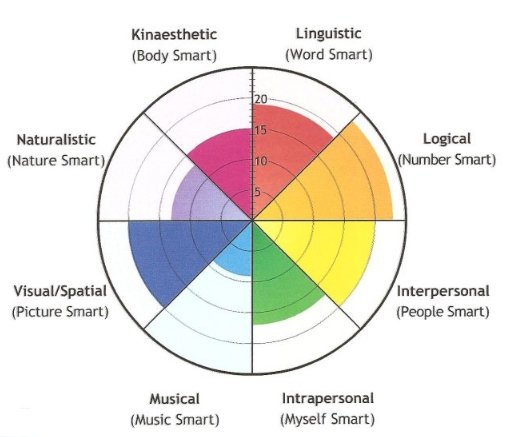Multiple intelligences
Different students are endowed with different learning abilities and capabilities that they normally use to solve problems and learn. Based on the broad spectrum of intelligence demonstrated by students, learning psychologists have come up with multiple intelligences aimed at helping such students (Lane, n.d).
What this seems to imply is that students have different types of minds and their learning process is also different. In addition, their abilities to understand what they are taught at the classroom setting also differ. For these reason, the performance of students in the same classroom setting varies.
Some of multiple intelligence results are provided below

Figure 1: Multiple intelligences results
Differentiated instructions of learning allow flexibility in grouping students. Accordingly, students are grouped based on their learning abilities and capabilities, thereby giving room for adjustments (Tillman, 2003).
Therefore, incorporating multiple intelligences with differentiated instructions would help to improve the education level of a student (Gregory, 2008). Small classrooms allow teachers to devote their time to individual students. Consequently, they are better able to apply musical or logical styles of learning because students’ levels of understanding differ.
Learning can improve when tailored to suit the varying needs of students (Ireh & Ibeneme, 2010). For example, students with musical intelligence can learn better under a musical background or when music is involved in the learning process (Lane, n.d).
According to Gregory (2008) and Gregory (2003), this enables teachers to understand their students better and the learning process may become enjoyable since teachers know the students’ weaknesses and learning abilities. In the absence of differentiation, it becomes hard to engage students with different learning abilities because disruptions in classrooms may occur, thereby causing segregation (Losen, 1999).
Assessment strategies
According to Lane (n.d.), assessment is carried out to determine whether students have progressed during learning sessions, or not. There are different methods of assessing learners in differentiated settings including pretests, checklists, surveys, post tests, quizzes, teacher observations, on-going assessments, self and peer assessments, checks, and reflections, among others (Gregory, 2008; Gregory, 2003).
All these methods are applied in both higher and lower learning classrooms to determine the performance of the students. As noted by Gregory (2008), pre-test assessment is used to meet the needs of different students. Furthermore, it shows the student’s ability, readiness, talents, and interests. This assists the instructor in profiling the student’s learning abilities (Ireh & Ibeneme, 2010). Post tests are conducted after the end of a learning session such as a semester to determine the extent to which a student has learned.
The above mentioned methods can benefit a high performing student in a low performing class since tests are used to measure the learning abilities which aid in assessing the performance of students. Through the outcomes of the assessment tests, an instructor is able to determine a student’s learning preference and interests.
On the other hand, the same assessment strategies would be applicable in a high performance classroom which has one or more low performing students. The rationale behind this is that in differentiated instructions, a teacher uses pretests and posttests to determine whether a student is ready for the next step, chapter or grade (Gregory, 2008). Therefore, pretests and post-tests assessment strategies would be applicable in high performing classrooms with a low performing student (s).
Reference List
Gregory, G. (2003). Differentiated instructional strategies in practice: Training, implementation, and supervision. Thousand Oaks, Calif: Corwin Press.
Gregory, G. (2008). Differentiated instructional strategies in practice: Training, implementation, and supervision (2nd ed.). Thousand Oaks, CA: Corwin Press.
Ireh, M., & Ibeneme, O. T. (2010). Differentiating instruction to meet the needs of diverse technical/technology education students at the secondary school level, African Journal of Education, 1(1), 106-114.
Lane, C. (n.d). Multiple intelligence. In. The distance learning technology resource guide. Retrieved from http://www.tecweb.org/styles/gardner.html
Losen, D. J. (1999). Silent segregation in our nation’s schools. Harvard Civil Rights-Civil Liberties Law Review, 34(1), 1-30.
Tillman, M. (2003). Differentiated instruction. Web.